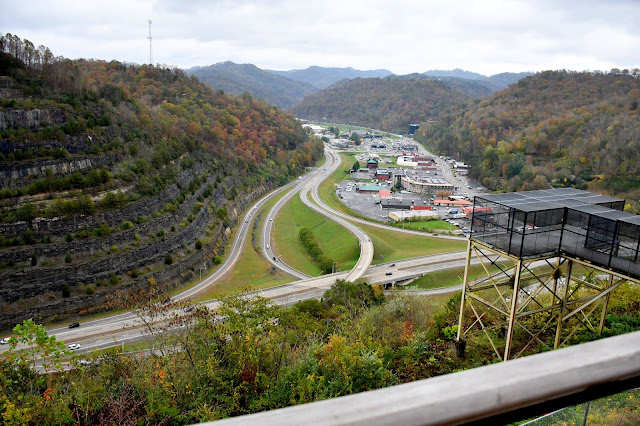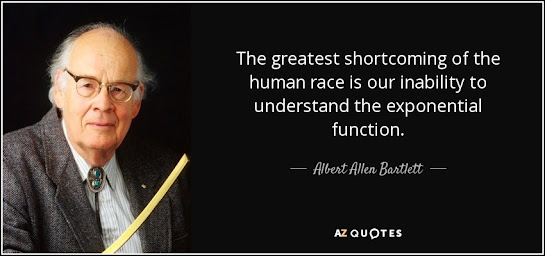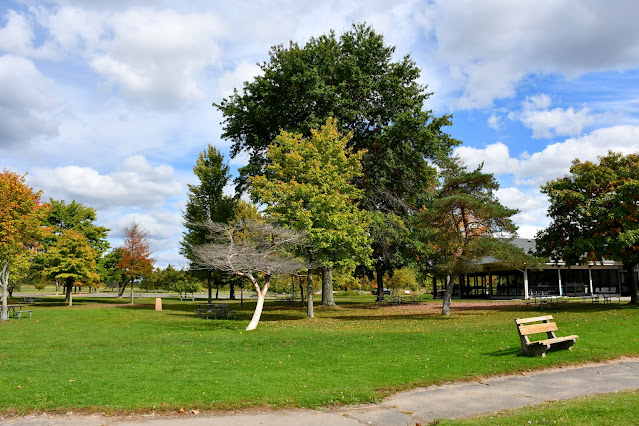Geological Events Show the Difference Between Predicaments and Problems
I want to start this article with a video by Philip Prince. I posted some of his videos along with Mark Huneycutt's videos a couple weeks ago to demonstrate, in a very real sense, the difference between a predicament and a problem (see The Dilemma and Conundrum of Predicaments). I defined these in my very first article many years ago (the article had actually been written a few years before I started this blog as a repository of files and had been updated and edited a few times before making it here). It should be noted that I had written several other articles before that one describing the conundrum we were in but that weren't quite as concise as to what the root issue was. Even since that article was written, I have pointed out that advanced technology use is a behavior of ours, something we choose to build and use. This requires innovation, engineering, energy, and material resources, and serves as the basis of the supporting platform for civilization.
All of this, of course, requires today's civilization in order to build and utilize today's advanced technology. A large portion of today's technological devices simply were not possible even two or three decades ago, because such small and precise devices able to manufacture miniature electronic integrated circuit boards didn't yet exist. This is what made our smartphones and all types of new, small, and lightweight electronic devices possible.
Here's an example from my own experience. When I first started my DJ/MC career more than 4 decades ago, a professional 400 watt/channel stereo amplifier was 4 rack spaces tall and weighed a hefty 85 pounds. Not more than a few years later, a new amplifier came onto the market which featured 600 watts/channel, was 3 rack spaces tall, and weighed only half as much at 42 pounds. It actually came in two pieces which could be joined together in a rack mounting adapter. Several years later (about a decade), we purchased new amplifiers; each which put out 400 watts/channel, was 1 rack space tall, and weighed about 16 pounds each. About another decade later, we discussed purchasing new amplifiers once again which put out 500 watts/channel, were two rack spaces tall, but only weighed 11 pounds each. (There are a host of other sizes of amplifiers we have that were used for various purposes, but those were in different power and size ranges.) Around this same timeframe, energy and resource decline became a topic I started researching. The writing was on the wall with regard to collapse and I was able to accurately predict the market demand for our services being reduced over time, and the facts I had uncovered were reflected in our market research conducted during and after bridal shows and other marketing and advertising events.
I currently use a 25 watts/channel stereo amplifier for my dual 6" bass reflex two-way computer speakers. It weighs less than 1 pound and fits in the palm of my hand, so electronics have come a long way. Most of the efficiency and size and weight improvements are now in the past, however.
Back to Philip Prince's video; I truly appreciate his analysis videos and explanations as to how geology affects real-world events such as flooding, landslides, and debris flows, and this one is extra special because he got out of the office to take us into the field to show what all of this looks like in person. Like Mark Huneycutt's videos, the sheer devastation is indeed stark, and even though I had seen Mark's videos showing this same devastation, Philip's description and analysis adds to the knowledge I now have with regard to these phenomena.
The sheer amount of force that these debris flows represent and the height that they reached as they moved down the slopes and sometimes up and over the far side as it went into an adjoining channel shows the devastating power of the exponential function.
When one sees these smaller events like this (in comparison to glacial outflows and other similar large events) and applies the domino effect as to how the exponential function operates in real life, one can easily see how overpowering the end effect really is. I have a great respect for mathematicians like John Peach (and many of you also know Becker Sidney Smith) who can apply numbers to all of this, demonstrating precisely why what we have accomplished with overshoot is beyond anything we can now stop or reverse. Even reducing the predicament seems to be asking too much, as few people will even entertain the vision of reducing their own technology use and consumption.
This isn't to say that a reduction is impossible. It's actually an imperative - either society can do it voluntarily or nature will enforce it. This is what collapse is all about. In fact, the evidence seems all too clear that things are continuing to move exponentially, as is indicated with the latest study (linked in the article here) regarding endocrine disruption and the human ability to reproduce. Just a couple years ago, if memory serves me correctly, the date the models showed that male sterility would be reached was 2060; now that date is 2045. Faster than expected and more than previously thought...not surprising but still frightening.
I know a significant number of folks who are into regenerative agriculture and permaculture and even some who live off-grid. Ultimately though, they still live within civilization's clutch no differently than the rest of us. Even cultures that have rejected living in a system supported by technology use such as Indigenous tribes still face most of the same predicaments we do because nature doesn't recognize anthropocentric borders. So, even though they have no contact or connection to the world outside of their lands, they will be equally affected by biodiversity decline, climate change, extinction, and pollution loading as everyone else for the most part. While I agree that regenerative agriculture and permaculture are great ideas for today, they unfortunately do not have the capacity to solve overshoot any differently than all the other ideas that folks frequently mention as "solutions." They are still technology use, the very behavior of ours that is at the heart of the predicament of overshoot in the first place. They are better ideas than industrial agriculture, but at the end of the day, agriculture is still agriculture and technology is still technology. For people who are passionate about doing it, good for them. Live Now!
Proponents of regen-ag and permaculture spend a lot of time talking about restoring and regenerating nature, and it's true that IF a majority of society embarked upon such a program that it might have some great effects. There's that "if" again. I constantly hear it - if, if, if, and then the famous "WE" - if "we" do this and if "we" do that. But "we" aren't, which is pretty much the entire point. Restoring and regenerating nature is unfortunately not the reality now and I don't see such a reality emerging anytime in the near future either, at least not for most of the industrialized world. Because the biosphere doesn't recognize borders, and because we lack agency to collectively ignore our biological imperatives, the degenerative processes that civilization consists of will affect all of us, regardless of what we do as individuals. Until industrial ag becomes more problematic than it already is, it looks like it will continue for the time being. Speaking of which, check out this new machine designed to eradicate weeds. So, in the meantime, the bargaining to maintain civilization continues unabated.
This preview into the hopium this presents leads us into next week's material. Until then, enjoy some time checking out Grayson Highlands!











A pretty convincing argument can be made that ALL agriculture is ultimately unsustainable. It's just a matter of time and scale. Intensive, industrial agricultural supporting a mega-population (the current model) will burn through the planet quickly -- a few centuries. Permaculture and other forms of regenerative agriculture will take longer -- many centuries. The most sustainable form of agriculture -- swidden agriculture -- will take even longer -- perhaps millennia. (Today approximately 20-30 million humans in southeast Asia are supported by swidden agriculture.) Perhaps the most sustainable model is a hunter/gatherer lifestyle augmented by some low impact swidden-style agriculture. This model will sustainably support about 100 million humans globally for a very long time-- that's a 98.5% reduction in population from where we are now.
ReplyDeleteI'm both more pessimistic and more optimistic than your appraisal.
DeleteYou seem enamoured of "swidden agriculture", ranking it more sustainable than Permaculture. But how could you think that slash-and-burn has any advantage over regenerative agriculture?
Have you ever taken a Permaculture Design Course? It really is different than slash-and-burn!
I'm not sure a hundred million humans are sustainable. James Hansen thinks we'll be reduced to a few million, clustered around the poles.
But it will still get cold in the winter. Most people seem to think that, on-cue, humans dropped their spears and picked up hoes, and we all switched from hunting and gathering to farming. But the switch was varied and uneven, sometimes going back and forth in a region, and generally taking one or two thousand years to happen.
In-between, something happened that may prove useful in the future, something you don't hear about, even though it's still practised (rarely) in some places: pastoralism.
I think the future will be humans herding dairy animals north to the Arctic Ocean in the summer, and then further south in the winter. This may be the only way forward in a world where plants and even many animals won't be able to keep up with climate change.
Pastoralism will require the end of private property in order to work. Good luck with that one!
When I was a child and young man, my family raised most of our own food. I am quite familiar with working the land and the elements of permaculture. True swidden agriculture is more sustainable long-term since it is more in keeping with natural ecological processes. 1) It relies on long fallow periods — 15 to 25 years — where cleared land is left to regenerate naturally. This allows forests to rebuild soil fertility through organic matter decomposition, and for woody growth to reestablish itself, mimicking natural forest cycles. 2) Swidden systems require minimal external inputs like fertilizers or irrigation, reducing dependence on industrial systems that may not be viable in post-fossil-fuel scenarios. 3) By alternating between cultivated and fallow phases, swidden systems preserve a mosaic of habitats, supporting a wide range of plant and animal species. Permaculture, while very much more ecologically sound than industrial agriculture, requires permanent human management and significant external inputs (i.e., a form of MTI civilization) to establish systems like food forests, making it less adaptable in contexts with limited resources or population pressures. As for population, I think establishing the earth’s carrying capacity at 100 million is reasonable, but it certainly could be fewer. I estimate that the planet can sustain about 10 million hunter gatherers and about 35 to 70 million swidden farmers. Because of the great uncertainties in making such an estimate, I rounded up to a 100 million maximum. As you say, it might be far fewer.
Delete